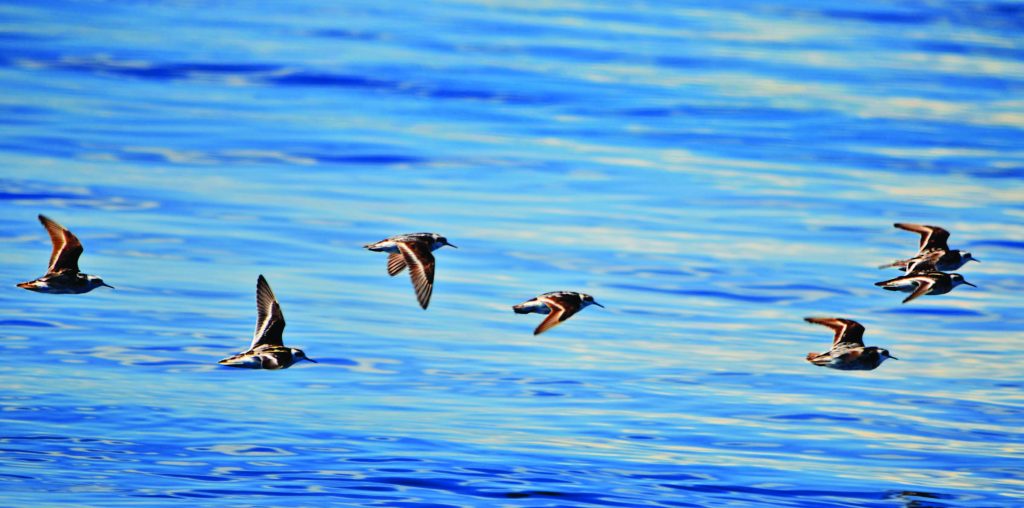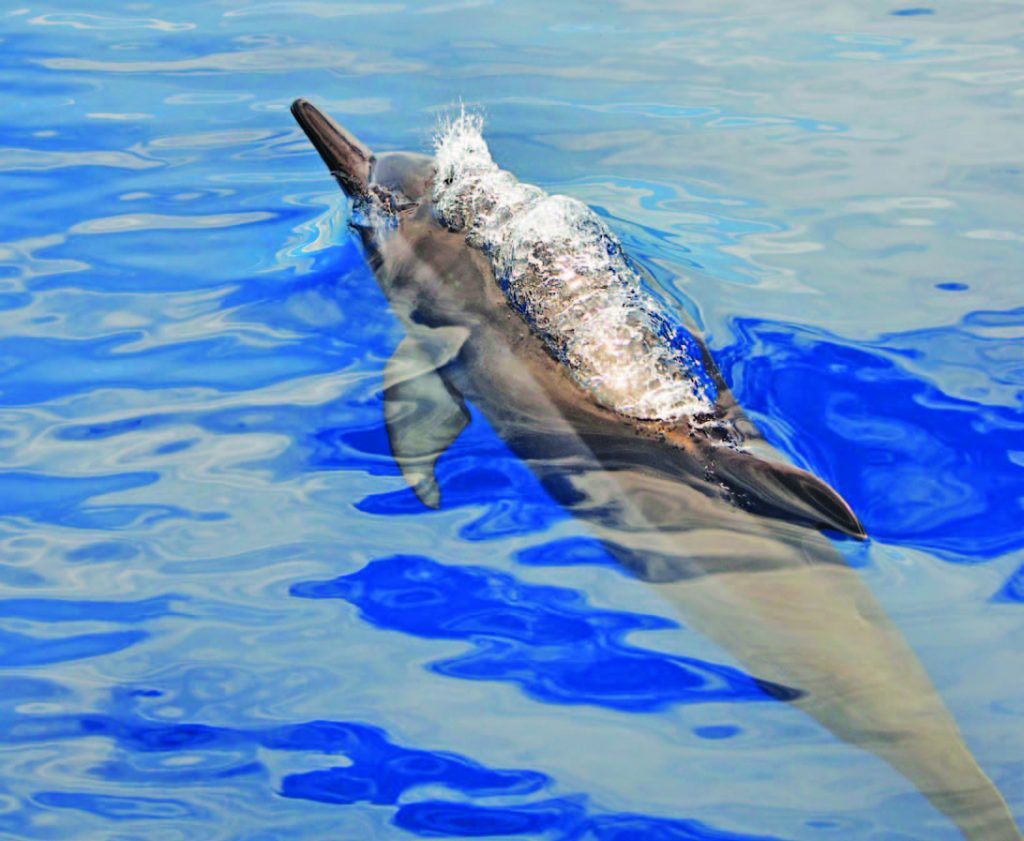Captain Ricardo Reynaldo finishes his prayer and gestures to the waters of Bais, strangely calm this morning.
“We’re in the Tañon Strait, known the world over for our dolphins and whales. Each of them has its own personality – bottlenose dolphins stay near the shallows, while acrobatic spinner dolphins play in open waters. Larger Risso’s dolphins like to float upside down, tails sticking out of the water – but the rarest of all is the pygmy sperm whale. It is very shy and only passes through our waters. It has been three months since I saw one. But perhaps,” he smiles. “Someone down there heard our prayers.”
Revving our engines, we ease out of the dock.

What are cetaceans?
We’re onboard the Ezrha, a motorized banca out of Bais, a quaint port town near Dumaguete. We’re here to look for cetaceans, an order of marine mammals which as per the IUCN, includes about 90 species of whales, dolphins and porpoises. About one third of these species inhabit or pass through Philippine waters, ranging from the 2.5-metre Irrawaddy dolphin to the 30-metre blue whale. The Tañon Strait, a 161-kilometre channel dividing Cebu and Negros, is home to 14 species, most of which can be seen around Bais.

“Cetaceans are extremely important for the marine ecosystem,” Dr. A.A. Yaptinchay, Director of the Marine Wildlife Watch of the Philippines, had told me in Manila before we’d left. “Most are apex or top-level predators which regulate populations of fish and squid – thereby keeping the ecosystem balanced to promote diversity. The bigger whales, especially filter-feeders, contribute to nutrient distribution in the sea through a ‘whale pump’ – fertilizing the sea surface with their poop, which encourages plankton growth.”
Once hunted and slaughtered for their meat and blubber, all cetaceans are now protected in the Philippines. Still, many die because of accidental entanglement in fishing gear, which can cause the air-breathing mammals to suffocate or drown. Known as bycatch, this is estimated to cause the deaths of over 300,000 whales, dolphins and porpoises globally every year. Other threats include marine debris and plastic pollution, habitat destruction, overfishing and hunting, which sadly still occurs in remote parts of the Philippines.
Spotting the pod
Thirty minutes after the Captain’s prayer, we’re swapping tales over breakfast, eyes only occasionally flicking across the horizon in cursory search of our quarry. I’m talking with a Marine Corps officer about his adventures in Mindanao when the grizzled boat Captain points to a seemingly empty patch of sea, abuzz with red-necked phalaropes, a species of small wader. “There! Look at the birds!”
Just over a kilometre off, blue water begins to churn under the circling phalaropes. In seconds, half-a-dozen people are scrambling for their cameras, breakfast forgotten.

Our boat approaches the site – a roiling, bubbling mass, seabirds squawking overhead. “It is a bait-ball, a giant school of sardines or other small fish driven up from the depths,” explains one of our boatmen. Cetaceans must constantly rise from the depths to breathe. Exhalations or blows of the largest species, the blue whale, can be as high as 20 feet! Cetaceans use up to 80% of their lung volume in a single breath, in contrast to humans, who use only 20%.
I’m waiting for the telltale white blow puffs when I see dark, triangular dorsal fins surrounding the bait ball. Dolphins. Dozens of them.
Suddenly, they start jumping. ‘Ooohs’ and ‘ahhhs’ fill the air, along with claps and cheers. I grin as I catch myself clapping along with everyone else. I’ve been watching dolphins for years and it’s like this every time. The Tañon Strait’s biggest stars are in action – spinner dolphins, distinguished by their elongated snouts and crazy, acrobatic leaps. Some somersault, while the real show-offs throw corkscrews, spinning two or three times before landing.
After a few frenzied minutes, Captain Reynaldo shouts the three words we’ve been waiting for all morning. “Pygmy sperm whales!”
Far less showy than the spinners, their appearance is more significant for they are rarely spotted at all.
Drawn to the commotion, a pair have come to snap up what the dolphins have missed. We don’t approach, staying the prescribed 100 metres from larger whales. I snap shots as fast as I can but they’re too far out. Remembering a scene from ‘The Secret Life of Walter Mitty’, I exhale and – reluctantly ¬at first – lower my camera. I take in the moment and reminded myself that often the best memories are recorded with your eyes, not a lens. After a magical minute, they’re gone.
Soon three more boats arrive and we turn back towards Bais to let other visitors enjoy. As I watch people excitedly jostling for prime selfie spots on their boats, I recall studies that suggest that cetaceans have exhibited numerous behavioral changes because of more frequent interaction with boats.
It’s a dilemma: how much is too much? Whale watching – a global industry worth over USD2 billion annually – directly supports cetacean conservation. But right across the strait from Bais is the town of Oslob on Cebu, a top tourist draw that has drawn much flak from the townsfolk’s practice of feeding whale sharks, the world’s largest fish.
The world has gone a long way from the large-scale hunting of whales and dolphins, with communities having largely shifted to tourism. But we must also manage tourism impacts to ensure that we’ll always have a whale of a tale when we visit places like the Tañon Strait. (AS)
Dos and Don’ts for Cetacean Interactions

1. Let cetaceans approach your boat. Do not chase them.
2. Stay at least 100 metres away from larger whales, such as baleen or sperm
whales.
3. Always give cetaceans an avenue to escape. Boats should stay together to
avoid boxing cetaceans in.
4. Stay with the animals for a maximum of one hour.
5. Keep your voices low. Please don’t shout.
6. Never ever attempt to touch or feed cetaceans or any wild animals.
This appeared in Animal Scene magazine’s December 2019 issue.
You might want to read:
– Scientists: Maui beached whales were fighting infections
– Canada announces new protections for rare right whales
– Japan whalers resume hunting after a three-decade hiatus, whale face extinction






